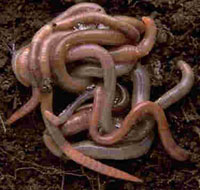 |
||
Ron’s ArticlesThe Early Bird Gets the WormFebruary 2006
On a cloudy day when it’s about 55 degrees, dig up a cubic foot of soil, screen it over a wheelbarrow and count your worms. If you find 10 or more, congratulate yourself. You have healthy well aerated soil. Worms are the soldiers of the soil. They work 24 hours a day - never resting. They digest organic matter and mix it with the soil to make earthworm castings. A worm can produce its own weight in castings every 24 hours. These magically transform your soil because they are up to seven times more nutritious than the native soil. They’re rich in calcium, nitrogen, phosphorus, and potassium among other things. Castings are loaded with mucous and resins that improve the structure of the soil. They also contain certain beneficial organisms that only multiply in the gut of a worm. While feeding, earthworms consume the spores of mycorrhizae, a beneficial fungi. These spores are too large to easily find their way to plant roots. But via the worm’s burrowing, they are deposited near roots where they explode into fungal hyphae that cause the roots to be up to 10 times more efficient in extracting nutrients. As that worm moves in and out of the soil, it pulls air in and pushes air out. It’s like the vascular and respiratory systems of your soil combined. If your soil fails the worm test, don’t worry. Feed the humus pipeline and they will come. Follow my recommended three stage program and your landscape will be healthy and happy by next summer. First, apply fully digested compost at the rate of one cubic yard per 1,000 square feet. That’s a layer about 1/3 inch thick. Wait a month, then aerate mechanically. The compost will have softened your soil allowing for a deeper penetration so that more air, water and nutrients will penetrate the soil increasing the flow in the humus pipeline. Between February 15 and March 15, apply a blended soil food to stimulate the microbe populations to break down organic matter faster and even pull nitrogen, carbon and oxygen right out of the air. This increases the carbon content of the soil - ideal is 4%. Most of the soil I test falls well below that - about 1%. I developed my Rons Blend with the help of K. Chandler, the founder of Texas Plant and Soil Lab and the most respected soil scientist in the state of Texas. I drew upon my 20 years of professional landscape experience combined with my fire fighter paramedic training. There are commonalities among all life forms. People don’t do well when they can’t breathe; neither does the life in the soil. Paramedic training emphasizes the importance of respiration and circulation. You have all the nutrients in the world, but they won’t support life unless they are delivered to the organism on a consistent basis. Everything I do is based on improving the circulation and respiration of the soil. Nutritionists recommend that we eat a wide variety of fruits, vegetables and proteins. You wouldn’t want to eat the same thing everyday. And, if you did, you’d suffer some breakdown due to nutrient deficiency. This is why I’ve developed my Blends with multiple ingredients fine-tuned to the seasons and soil types. Each Blend has 10 or more ingredients. Bio solids form the base - a perfect protein with complex amino acids. These attract billions of microbes from the feet of every living thing that comes in contact with your property. Microbes are everywhere. They’re on the feet of cats, birds and frogs. They’re on your shoes and mower wheels. But they don’t stick around unless they sense the necessary nutrients in the soil. Rons Spring Blend includes ingredients to stimulate new growth. Corn Gluten meal is a pre-emergent loaded with nitrogen for early spring growth. Cottonseed meal, high in acidity and loaded with nitrogen, also has pre-emergent qualities. Soybean meal stimulates beneficial fungus and bacteria. Alfalfa meal loaded with tricontanol - a growth hormone and a fungal stimulant. Cornmeal stimulates trichoderma - beneficial fungi that feed on harmful pathogens. Molasses is Gatorade for all the organisms giving them a charge of energy when they get tired. Feed grade urea supercharges certain species of beneficial bacteria and fungus. I add 36 natural mined mineral high in silica and sulfur-potassium-magnesium - sul-po-mag. Remember, the early bird gets the worm. Get started now. Worms are like people. Feed them and they will come. Saving the world one yard at a time. 
|
|
|


|
||
